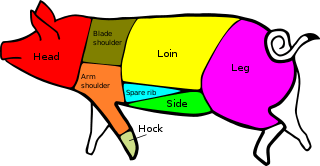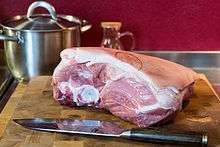Boston butt


Boston butt or pork butt is the American name for a cut of pork that comes from the upper part of the shoulder from the front leg and may contain the blade bone.[1] Boston butt is the most common cut used for pulled pork, a staple of barbecue in the southern United States.
In the United Kingdom, Boston butt is known as pork shoulder on the bone, since regular pork shoulder normally has the bone removed and then rolled and tied back into a joint.
History of the name and cut
In pre-revolutionary New England and into the American Revolutionary War, New England butchers tended to take less prized cuts of pork like hams and shoulders and pack them into barrels for storage and transport, known as a butt. This particular shoulder cut became known around the country as a Boston specialty, and hence it became the "Boston butt."[2] In the UK it is known as "pork hand and spring", or simply "pork hand".
In Spanish the cut is known as paleta de puerco,[3] and is the main ingredient in the Mexican dish carnitas[4] and in the Cuban dish lechon asado.[5]
In Mexican Spanish, this cut is also known as the espaldilla (literally "little back").
References
- ↑ "Cuts: Shoulder". TheOtherWhiteMeat.com. National Pork Board. Retrieved 16 October 2009.
- ↑ Ethan Trex (July 30, 2009). "How 9 Cuts of Meat Got their names". Mental Floss.
- ↑ Lourdes Castro (10 November 2009). Eat, Drink, Think in Spanish: A Food Lover's English-Spanish/Spanish-English Dictionary. Random House Digital, Inc. p. 259. ISBN 978-1-58008-954-8. Retrieved 28 October 2012.
- ↑ "Carnitas." Food Resource, Oregon State University. Accessed October 2012.
- ↑
